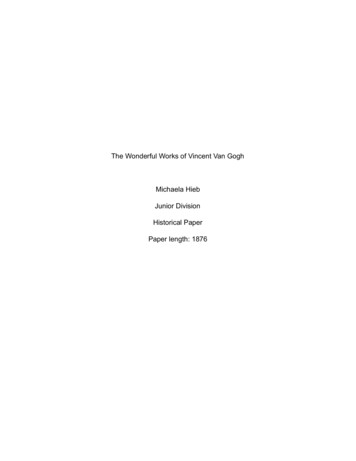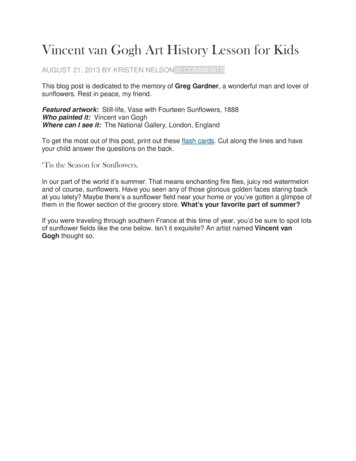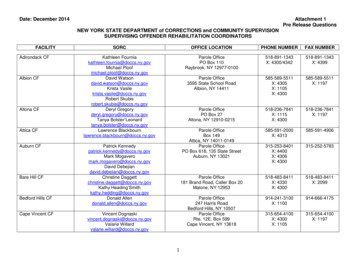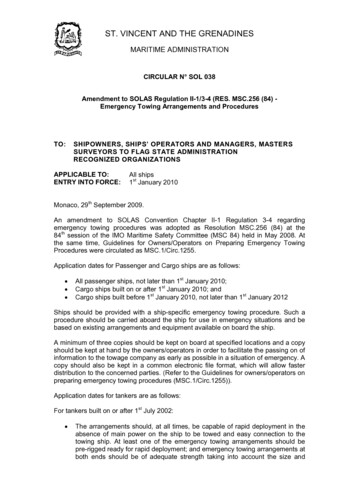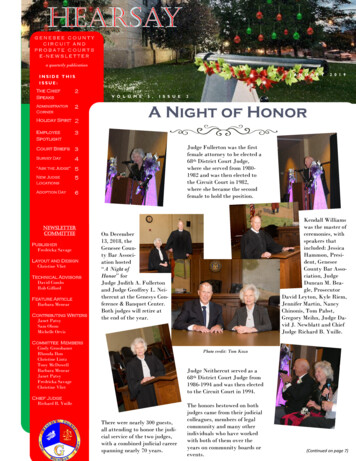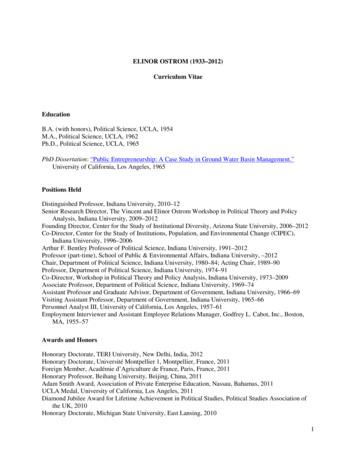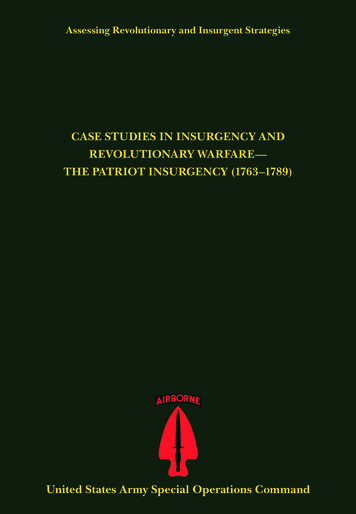
Transcription
“Vincent Ostrom’s Revolutionary Science of Association”1Abstract: The paper assesses Vincent Ostrom’s critique of contemporary mainstreamapproaches to political theorizing. Ostrom challenges the epistemic choices at the foundation ofmodern political science and proposes a “democratic” alternative based on the theory offederalism he derives from The Federalist and Tocqueville’s Democracy in America. The paperexamines Ostrom’s scholarship, relates it to the empirical research Elinor Ostrom and heconducted, advised, or sponsored at The Workshop in Political Theory and Policy AnalysisIndiana University, and concludes that Ostrom’s democratic alternative meets the definitionalconditions of an alternative scientific paradigm as outlined by Thomas Kuhn in The Structure ofScientific Revolutions. The paper presents a framework for comparing alternative theories ofpolitics and policy analysis and for assessing their relative successes at making warrantableempirical claims.Michael A. Fotos, III, Ph.D.Lecturer in Political Science, Ethics, Politics, and EconomicsYale University, New Haven CTAssociate Program Director, Public Policy Graduate ProgramTrinity College, Hartford CTMarch 15, 20131Working paper prepared initially for presentation to the Yale Center for the Study of Representative Institutions,subsequently revised for presentation at the Vincent and Elinor Ostrom Workshop in Political Theory and PolicyAnalysis. Please do not cite without permission. Any comments or suggestions would be greatly appreciated by theauthor and will help inform subsequent drafts of this paper. The author thanks Danilo Petranovich of the YaleCenter for arranging the original presentation, Tyler Carlisle, Yale Class of 2015 for comments on an early draft,and Kate Fotos, Loomis-Chaffee School, Class of 2013 for proofreading. Copyright reserved by author.1
“First let me persuade you of my metaphysics and epistemology, then my theoryof science, then my ethics and social theory, and then having done all that, I willconvince you of my political theory. Over the past two decades, I have becomeconvinced that this is a mug’s game The reason Plato, Hobbes, Marx, Mill, andRawls (many others could be named) garner widespread attention as politicaltheorists has much more to do with their destinations than with their startingpoints.” (Shapiro 2011 254)IntroductionIan Shapiro neatly sums up the problem of writing this paper and its resolution. Myquestions have their basis in metaphysics and epistemology but the reason anyone should caredepends primarily on the purpose for asking them. Our politics and policy have gone seriouslyoff track in the United States because we have forgotten or chosen to ignore basic principles ofthe art and science of association. The result is a crisis of governance with constitutionalimplications. Our national education policy prescribes impossible goals and costly remedies to schoolsembedded in social and institutional settings that make success a cruel illusion. Our national health policies expend vast sums treating people for preventable illnesses ofwhich they will never be cured.2 We have a national food policy premised on subsidizing commodity producers while anepidemic of obesity has people literally dying of food. Our home finance policies have wiped out a generation of middle-class savings andplaced millions of people in homes they cannot afford to keep and cannot sell.2Kudos to Dr. Aaron Shirley (nytimes.com 2012a) for his apt descriptions of our national healthcare debacle and theobesity epidemic.2
We have an array of urban policies that have made cities less desirable places to live,work, and invest. Our school desegregation policies systematically assure segregated outcomes. We have a national drug policy that has ruined millions of lives and led to the murder oftens of thousands of people with little measureable effect on the human proclivity forrecreational self-medication. We have a national fisheries policy that assures the depletion of keystone fish species.All of these outcomes (and others the reader might add) are contra-indicated by mainstreamtheories of government and administration. In the parlance of experimental science, they areanomalies, experimental results contrary to the terms and conditions under which theexperimenter conducted the experiment. 3 In plain language, the proponents of these policies,who are for the most part experienced policy practitioners, expected one thing and got somethingelse. “Perhaps this is an occasion that we should entertain an outlandish hypothesis: that ourteachings contain much bad medicine.” (V. Ostrom 2008b, 4)3Needless to say, proponents and beneficiaries of present policies do not describe the results of their politicalexperiments as unexplained anomalies. Rather, they “explain” poor policy results by resort to “bad people” theories(conservative ideologues, squishy liberals, greedy bankers, etc.), “bad object” theories (money in politics, SUV’s,violent video games, etc.), or “great abstraction” theories (corporate greed, bureaucratic red tape, hyper-partisanship,etc.). I have no doubt that every item listed above has implications for politics and policy in some way but reflectionon the logic of constitutional choice from The Federalist demonstrates that virtue and vice, named objects, andundesirable properties of the human condition are of secondary relevance to a warrantable theory of selfgovernment. If we presume that a theory of political institutions is possible, the following statements must be true.If they are not true, then the possibility of such a theory is called into doubt. (1) Communities of people can selecttheir constitutions by reflection and choice and are not always dependent on accident and force. (2) If people wereangels, no government would be necessary, but since they are not, governments are necessary. (3) Properlyspecified federal arrangements create the potential for a government strong enough to serve the public’s purposes,yet also flexible enough to provide and produce complex packages of public goods and services. (4) Constitutionsare laws made by the people establishing the terms and conditions that bind the government (not a trivial problemgiven the “no angels” condition). The theory of federalism, properly understood, accounts for the absence of virtueamong office holders, has no inherent limit on its capacity to govern “objects,” and relies for effect not on greatabstractions but rather upon communities of people with the skills and the collective intentionality to establish andordain such a constitution. See V. Ostrom 2008a.3
Ostrom did more than simply “entertain” the hypothesis that mainstream politicaltheories contain much “bad medicine.” He claimed empirical confirmation of the hypothesisciting as evidence the social pathologies that followed from late 20th century choices inconstitutional and policy design and he logically demonstrated their causes by developing a“polycentric” theory of federalism. Moreover, Vincent and Elinor Ostrom and their colleaguesat The Workshop in Political Theory and Policy Analysis Indiana University (hereafter TheWorkshop) conducted, advised, or assisted in a global research effort to develop an alternativeframework for making testable claims concerning the terms and conditions of our politicalexperiments. This paper has two purposes, to assess the assertion that The Workshop approachto political theory and policy analysis, which I call Ostrom’s democratic alternative,4 comprisesan alternative scientific paradigm and to provide a framework for comparing and evaluating themainstream of political theory and the alternative.I proceed by addressing three questions. What are the bases for differentiating Ostromfrom the intellectual mainstream? To what extent do these differences substantiate Ostrom’sclaim that the art and science of association he proposes constitutes a paradigmatic challenge tothe intellectual mainstream? What empirical grounds does Ostrom give us for preferring hisproposed “democratic alternative” to the mainstream?Appraising The Workshop tradition in political researchElinor Ostrom’s 2009 Nobel Prize in Economic Sciences was remarkable in severalways. She was the first female to be so recognized. She was the first recipient who studied andtaught as a political scientist, and whose career is primarily identified with the discipline, whichshe served in many capacities including a term as president of the American Political Science4In chapter 4 of The Intellectual Crisis in American Public Administration, Ostrom refers to “democraticadministration” as the “rejected alternative” of mainstream scholarship. I use “Ostrom’s democratic alternative” torefer to the whole of his theory of democratic self-government in a limited constitutional republic.4
Association. At the time of her award, she was not particularly well known among economistsand indeed her widely-ranging scholarly interests in urban services, environmental governance,and institutional analysis are considered by many economists to reside outside the discipline’smainstream (Rampell 2012).Ostrom’s Nobel sparked a reappraisal of her work and necessarily also of the work ofother scholars associated with The Workshop that she cofounded and for many years co-directedwith her husband Vincent Ostrom.5 Since they passed away in June 2012, scholarly interest intheir work remains elevated, as for example a pending special issue/symposium of Publius: TheJournal of Federalism dedicated to the critical examination of their contributions to the study offederalism (John Kincaid, personal communication) and an online “virtual issue” of PublicAdministration Review articles they authored. 6Vincent Ostrom was a passionate advocate for democratic self-government based onlimited constitutional principles. He was also a political theorist and policy analyst of greatrange and ambition, who undertook a multi-decade quest to understand the terms and conditionsof political experiments wherever communities of people seek to live in rule-ordered societies.He demanded that we think critically about the way we think about social reality. It was ademand that he made of himself, his students, and his readers. His home laboratory was theNorth American continent and so the experiments he observed and analyzed have a strongly5Policy Studies Journal filled its February 2011 (39:1) issue with current and review articles in or on The Workshoptradition including an introduction by Elinor Ostrom.6My involvement with The Workshop began in the fall of 1994 when I enrolled in the graduate program in politicalscience at Indiana University. It continues, albeit at a distance, with a teaching career in political theory and policyanalysis heavily influenced by Workshop themes and scholarship. My engagement with Vincent Ostrom’s politicaltheory has deepened substantially in the last 18 months as I’ve undertaken to write a short volume reflecting onteaching policy analysis and institutional theory according to Workshop principles. This project would beimpossible were it not for the support of Patty Lezotte, The Workshop’s Publication Manager who has helped mepersonally in so many ways that go beyond counting and Barbara Allen who edited and offered expert commentaryin two recently published volumes of Vincent Ostrom’s papers, lectures, letters, memos, and other writings as notedbelow.5
American component. He recognized the decades preceding and following the Americanconstitutional convention of 1787 as one of the most productive periods of politicalexperimentation of the modern era. So naturally, he gave the analytics of the Framers andTocqueville a great deal of attention (Ostrom 1994, 2008a, [Allen (ed.)] 2012, 425f.)Nonetheless, his interests in democracy and self-government were global and he aspired todevelop frameworks of inquiry and theorizing with general application to all self-governingsocieties.7Ostrom can rightly be considered a revolutionary in the science of association. From the1971 lectures that became the core chapters in The Intellectual Crisis in American PublicAdministration until the end of his career, Ostrom systematically criticized and urged reform ofthe first principles of mainstream 20th century American political science and publicadministration theory. From the beginning, he described the intellectual mainstream as aparadigmatic challenge “of Copernican proportions” to the foundations of democratic selfgovernance (V. Ostrom 1977 1509, 2008b). His reference to Thomas Kuhn’s template forscientific change serves the purpose of giving structure to the critique and of suggesting possiblepathways to reforming the discipline and the practice of governance (V. Ostrom 2008b).The critique is sweeping. In published and (previously) unpublished work spanning fivedecades, Ostrom detailed normative, metaphysical, ontological, epistemological, theoretical, andempirical problems with mainstream approaches to what he referred to as “the art and science of7Barbara Allen’s commentary and a selection of essays and correspondence relating to Ostrom’s work with theAlaska statehood constitutional convention in Volume 1 of The Quest to Understand Human Affairs describe howOstrom came to realize the continuing relevance of constitutional choice to contemporary problems in policyanalysis. The essays in Volume 2 provide many examples of the global reach of his efforts to understand anddevelop theories applicable to widely diverse conditions where communities of people attempt to govern themselvesfor themselves.6
association”8 (V. Ostrom 1994 211f.). He linked some problems in the intellectual mainstreamto difficulties of language and methodological limitations (V. Ostrom 1977, 1510; 1980);however, problems of language and methods were secondary to and in many ways explained byproblematic epistemic choices that define mainstream approaches to the study of politics,government, and administration (V. Ostrom 2008b).Thomas Kuhn and Scientific ParadigmsIn the second decade of the 21st century, it is difficult to refer to the term “paradigm shift”without thinking of its descent from an innovative interpretation of changes in scientific practiceto a punch line in a cultural satire by Tom Wolfe.“But this word ‘paradigm’ absolutely drove him up the wall, so much so that hehad complained to the Wiz about it. The damned word meant nothing at all, nearas he could make out, and yet it was always ‘shifting,’ whatever it was. In fact,that was the only thing the ‘paradigm’ ever seemed to do.” (1989. A Man in Full.71, quoted in Godfrey-Smith 2006, 76)Popular use of the term “paradigm shift” likely surpasses the level of attention given to parsingKuhn’s study of the history of science. Nonetheless, Ostrom presumes reader familiarity withthe essential features of Kuhn’s narrative. Thus, he employs the story of “the Copernican turn”in astronomy, when astronomers gave up on the “self-evident truth” of a geocentric solar systemin favor of the revolutionary and imaginative leap to belief in heliocentricity. For Ostrom, thehistorical analogy fits his call for public administration theorists to question the “self-evidenttruth” that social order is possible only in centrally managed systems and to imagine the8Ostrom used the term “art and science of association” with direct acknowledgment of Tocqueville’s extendedexamination of what citizens in a self-governing society would have to know in order to constitute a self-governingsociety (1994, 211f.).7
possibilities of a polycentric system of order he called democratic administration (V. Ostrom2008b).As Kuhn’s early readers noted and he himself later acknowledged, Kuhn used the term“scientific paradigm” in a variety of contexts and to refer to demonstrably different things(Godfrey-Smith 2006, 77; Kuhn 1996 “Postscript—1969”). Three of Kuhn’s definitions apply tothis paper. A scientific paradigm can refer to “a way of doing science” (Godfrey-Smith 2006,77). It can refer to a successful experiment that is uniquely influential, an “exemplar” that solvesan important puzzle or resolves a troubling anomaly (ibid.). Or, a scientific paradigm can referto a shared network of commitments and implicit knowledge that define a community ofscientists (Kuhn 1996, 40-2).A different way of doing social scienceTo what extent do The Workshop scholars and investigators in their orbit “do science”differently than scholars working in the mainstream?Scientists engaged in different “ways of doing science” ask different questions and findmeaning in different kinds of data (Kuhn 1996, Godfrey-Smith 2006, Luker 2008). My firstmemory of a Workshop event occurred before the event, its purpose now long forgotten. I waswalking across the Bloomington campus with a member of the political science faculty when heturned to me and offered advice to the effect of, be careful about getting involved over there oryou may find yourself counting trees in Nepal.9 A bit of projection allows one to imagine aparallel conversation a few years later occurring between a member of the Yale political sciencefaculty and a newly enrolled graduate student upon the student’s first attendance at an Institutefor Social and Political Studies (ISPS) event hosted by Donald Greene and Alan Gerber. Be9At the time, a number of Workshop scholars were engaged in community forestry studies around the world. For areview, see E. Ostrom and H. Nagendra 2006.8
careful about getting involved over there or you may find yourself door-knocking inBridgeport.10 The operations of the two research institutes are recognizably similar but thequestions and the data differ substantially. The author concedes that these differences mayreflect simple differences between fields of inquiry. If so, the point merely confirms the vagariesof life as a graduate student. On the other hand, if one considers the respective ontological,theoretical, and normative commitments of the two research centers, the differences take ondeeper meaning.Workshop scholars study institutions conceptualized as long-lasting, rule-orderedrelationships shared among communities of people, a very broad definition that encompasses avast range of human activities (E. Ostrom 1990, 2005, 2009, 2010). The basic theoreticalcommitment can be summarized by the phrase, “Different arrangements will lead to differentresults or consequences.” (V. Ostrom [Allen (ed.)] 2011 180). The normative commitmentlogically follows. Workshop scholars count trees, fish, water pumps, even lobsters to assess theperformance of institutions.Voting and elections, the subject of the Green and Gerber experiments, are thepresumptively legitimate means for assuring popular representation in government and so theyoccupy center stage in the study of democracy as conceptualized by mainstream (including ISPS)scholars. Voter participation in the central acts of selecting those who govern in the people’sname is a key measure of democratic legitimacy. The normative commitment to count (andstudy) voters follows logically from the normative conceptualization of democracy.Scientific paradigms as uniquely successful experiments10The Institute for Social and Political Studies has been home to much innovative voter research, happily a traditionthat continues. For a review of the research referred to above, see Green and Gerber 2004.9
Elinor Ostrom’s Nobel award recognizes a successful career in experimental science thatachieved the resolution of at least two significant unsolved puzzles (anomalies) of mainstreamsocial science along with the development of frameworks and theories that either did solve orpromise to solve additional puzzles. In this section, I describe a portion of her research agendato illustrate how The Workshop’s empirical studies grew out of Vincent Ostrom’s theorizing andin turn contributed to its further development.11In 1961, Vincent Ostrom and co-authors Charles Tiebout and Robert Warren proposed atheory of organization applicable to metropolitan governments that relied on “polycentric”governance institutions to provide and produce public goods and services. The article offered atheoretical rebuttal of the then prevailing mainstream views favoring consolidated metropolitangovernment. Ostrom, Tiebout, and Warren had set the stage for empirical tests of monocentricversus polycentric systems. Soon enough, Elinor Ostrom and others undertook studies ofmetropolitan police departments and other urban service organizations that tested claims made inthe 1961 article and largely validated the feasibility of polycentric public service provision anddelivery systems (McGinnis and Ostrom 2011). These studies also developed techniques formeasuring the quality and efficiency of a variety of municipal services and for assessing thefactors that influence the quality and efficiency of service provision and production (E. Ostrom1971, E. Ostrom and Parks 1973, E. Ostrom, Parks, and Whitaker 1974). The “police studies” asthey were generically known contributed to the development of the concept of public serviceindustries, an idea with origins in Ostrom, Tiebout, and Warren (1961), which Vincent andElinor Ostrom elaborated on in the co-authored essay “Public Goods and Public Choices: The11For an overview of Elinor Ostrom’s research agenda in her own words, I recommend reading her 2009 Nobellecture as revised and published in American Economic Review (Ostrom 2010).10
Emergence of Public Economies and Industry Structures.”12 Ostrom and Ostrom (1977) explainthe relationship between the attributes of certain packages of goods and the organizational meansfor providing for and producing those goods. The concept of the jointly produced, jointly used,public good had been described previously.13 Ostrom and Ostrom extended the application ofthe concept to the analysis of public service industries by locating “pure” public goods in atypology of goods organized according to production and use attributes (V. Ostrom 1994, 163f.).The Ostrom typology and the narrative and evidence supporting it resolved an anomaly of publicadministration theory by explaining what mainstream scholars could not. Mainstream theoristspresumed that consolidation and centralization would improve the efficiency of public serviceprovision and production and yet, the most centralized city administrations provided the worstservices whereas fragmented, overlapping, and small jurisdictions offered better services atlower cost (V. Ostrom 2008b). The categorization of economic goods according to productionand use attributes enables the analyst to conceptualize a polycentric public service economycapable of providing and producing complex packages of public, private, mixed, and coproduced public goods and services, a capability not theoretically possible according toconventional institutional approaches (V. Ostrom and E. Ostrom 1977 in V. Ostrom 1994).Moreover, the logic of polycentric, multi-organizational systems provides an empiricallytestable, deductive framework for matching the scale and scope of public services to the scaleand scope of their effects (Ostrom, Tiebout and Warren 1961, McGinnis and E. Ostrom 2011).In short, by the mid-1970’s Workshop scholars had produced warrantable explanations of policy12The essay was originally published in Alternatives for Delivering Public Services: Towards ImprovedPerformance, edited by E. S. Savas, 1977, Boulder CO: Westview Press.13The Ostroms acknowledge Aristotle for an early description of the problems of common use and Samuelson(1954), Buchanan (1970), and Olson (1965, 1969) for later contributions to describing public goods. This authornotes Ronald Coase (1960, 1974) his early recognition of the institutional possibilities for providing and producingpublic goods and “bads” (i.e. social costs).11
pathologies associated with the consolidation efforts of urban reformers in middle decades of the20th century, a central element of the critique Vincent Ostrom delivered in the 1971 lectures thatproposed the “bad medicine” hypothesis, and theories derived from that work continue to explainthe perverse outcomes attending nationalization and centralization of domestic policy in thepresent.Governing the Commons: explaining the not-always inexorably tragic commonsIn 1968, the journal Nature published Garrett Hardin’s essay “The Tragedy of theCommons.” It was then and remains today a touchstone of the environmental movement.Hardin summons the evocative image of herders trapped in a race to capture the last blade ofgrass from a commonly held pasture and asserts that ruin can be averted only by choosingbetween two institutional arrangements, assignment of the grassland to private owners or to thestate, a choice premised on “mutual coercion, mutually agreed upon” (Hardin 1968 1248).Hardin’s juxtaposition of markets and states defined environmental debates for decades and mypersonal experience as an activist and public official confirms that many people with similarexperiences view the markets-versus-states dichotomy as self-evidently true.As Elinor Ostrom noted in Governing the Commons (1990), a metaphor is a literarydevice and not a fully developed political theory. Moreover, the dichotomy of markets or statesis false and ultimately harmful to adequate understanding of resource governance regimes (ibid.).Under the Ostroms’ direction, The Workshop supported an extensive, decades-long, globalprogram to study common property regimes that resulted in the collection and coding ofthousands of case studies with the goal of establishing a uniform method for comparinginstitutional performance among cases involving diverse resources, cultures, and geo-physicalsettings (E. Ostrom 1990, 2005, 2010). The assembled evidence confirms that ruin is not12
inevitable, that cooperation to maintain a common resource is possible (under diverse butspecifiable conditions), and that many (perhaps most) successful resource management regimesinvolve governance structures that are neither principally market nor state derived (Ostrom1990). Subsequently, Ostrom and co-authors Roy Gardner and James Walker (1994) organizedand conducted laboratory experiments designed according to principles derived from gametheory for the purpose of testing the field-derived “design principles” reported in Governing theCommons (Ostrom 1990). For the remainder of her career, Elinor Ostrom continued to develop ageneral theory of institutional design much of which she presents in her book UnderstandingInstitutional Diversity (2005). Her later work refines and largely confirms the earlier findings(E. Ostrom 2005, 2009, 2010, 2011; Ostrom, Gardner, and Walker 1994).The shared network of commitments and implicit knowledgeReading Vincent Ostrom leads me to believe that the third definition, the scientificparadigm as a shared network of commitments and implicit knowledge (Kuhn 1996, 40-42, 181186) is the one he had most in mind when framing his challenge to the mainstream. Kuhn (42)characterizes the network (or constellation) of shared commitments as “conceptual, theoretical,instrumental, and methodological.” He characterizes implicit knowledge by offering examples,such as shared understanding of what constitutes acceptable predictive accuracy (ibid. 185).Ostrom (2008b, [Allen (ed.)] 2012, 253f.) patterns his descriptions of paradigms after Kuhn,characterizing theoretical presuppositions by the shared foundational (i.e. ontological andepistemic) choices of scientists. He (Ostrom) proceeds by the method of textual exegesis toestablish a “mainstream constellation of commitments” and a further contrasting set ofcommitments as the alternative. Table 1lists the differentiated networks of commitments and sooutlines an operational definition of each “paradigm” enabling comparison.13
Insert Table 1 about here (Quasi) Metaphysics: different commitments, different outcomesKuhn (1996, 41) saves the reader and author from a lot of arm-waving by inserting themodifying “quasi-” before metaphysical when referring to the manner in which scientists addressthe problem of ultimate reality. Kuhn’s terminology is fortunate for a paper on political theorybecause the subject, politics, is entirely a social construction. The fact of social constructionmakes the claim of ultimate political reality a matter of great importance to the way we employscientific methods to study politics for the obvious reason that politics is as we construct it. If“[t]he history of all hitherto existing society is the history of class struggles” (Marx and Engels1848) and if politics is “who gets what, when, and how” (Lasswell 1958) then we have expresseda commitment to one form of ultimate political reality. If the community of scholars andpractitioners construct politics as an exercise in power, conflict, strategy, manipulation, and thepursuit of basic (self) interests, they will succeed in that construction (Lasswell and Kaplan 1950,Schattschneider 1960, Riker 1986, Shapiro 2011). If scholars and practitioners embrace analternative, covenantal reality, based on reciprocity, mutuality, and deliberation in a spirit ofcurious enquiry (Allen 2005), then the possibility of cooperation for mutual benefit arises and itbecomes feasible to construct politics as a collective effort to stabilize expectations concerningjoint and non-joint strategies (E. Ostrom 1990, 2005). The reader may presume that the latteroption is hopelessly naïve. Possibly so as Ostrom (1980) concedes but the point, taken fromHobbes, is that values are inescapable components of all political theorizing. We cannot answerthe question of what politics is without also answering the question of what it is for.“The ideas of economists and political philosophers, both when they are right andwhen they are wrong, are more powerful than is commonly understood. Indeed,14
the world is ruled by little else. Practical me
"First let me persuade you of my metaphysics and epistemology, then my theory . Our national education policy prescribes impossible goals and costly remedies to schools . and an online "virtual issue" of Public Administration Review articles they authored. 6 Vincent Ostrom was a passionate advocate for democratic self-government based .

